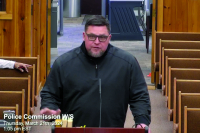High impact development ordinance to protect vulnerable populations

Haywood County commissioners are considering an ordinance that would ensure that certain types of developments do not pose adverse effects to residents.
The proposal had its first reading at the Haywood County Board meeting on Aug. 8.
On July 25, the Haywood County Planning Board worked through a list of different land uses in the county that could hold potential dangers for the community, deciding on what were appropriate setback, separation, and water buffer requirements for such developments.
Planning Director Kris Boyd presented the proposed ordinance to commissioners.
The ordinance mentions seven different types of operations subject to regulation — chemical facilities, asphalt plants, companies dealing in explosives, mining or extraction operations, hazardous materials handlers, landfills and combustible or flammable bulk fuel storage facilities.
Chemical facilities and companies dealing in explosives and hazardous materials handlers were further subdivided into “Class I” and “Class II” entities, with Class I being composed only of retailers and Class II consisting generally of manufacturers or producers who will face stricter requirements.
Related Items
The property restrictions relevant to such high-impact development are being proposed in order to protect what the county calls “vulnerable populations” and what Boyd called “people who, in the event of an emergency, may not be able to help themselves” if an evacuation is ordered.
Included in those vulnerable populations are public and private schools, child care operations, day care centers, hospitals, nursing homes, retirement and assisted living facilities, and correctional institutions.
Separation requirements demand that the closest point of an active area utilized by a high-impact development be no closer to any vulnerable population than the minimums proposed in the ordinance.
The highest separations are for fuel storage operations, landfills, mining operations and Class II chemical and explosives facilities; however, the “active area” stipulation means that such non-dangerous property features — like parking lots or office buildings associated with such facilities — needn’t be subject to the distance requirements.
Setback requirements, however, specify a minimum distance from the property line for all structures. Also included in the ordinance are requirements for a vegetative buffer and safety fencing.
Commissioners reacted favorably to the ordinance and conducted limited discussion; Bill Upton called it “common sense,” and Kirk Kirkpatrick had nothing to say about it at all.
Kevin Ensley proposed adding churches to the protected populations, saying that he thought elderly populations attending could be at risk; Mike Sorrells voiced concerns over the large separation requirements for bulk fuel storage facilities, which theoretically includes gas stations.
Although it’s still too early to speculate what changes in the proposed ordinance will result from the discussion, Boyd told the commissioners that at this stage, further stipulations could be added or removed at the board’s discretion.
Board Chairman Mark Swanger said that the proposed ordinance — along with any revisions — would be taken up at the next meeting “at the earliest.”









